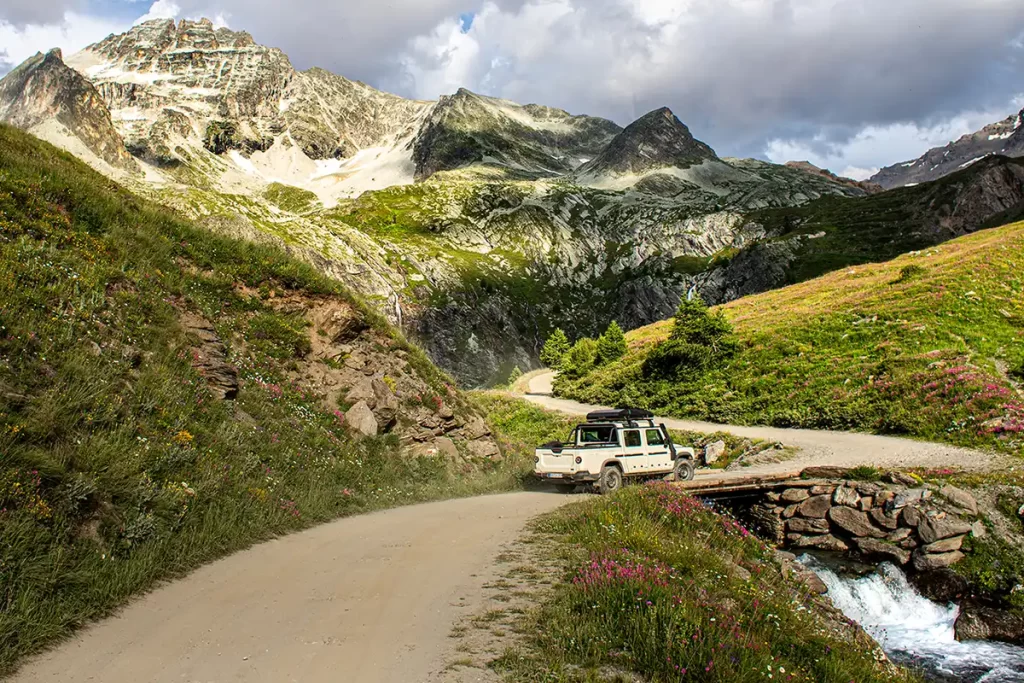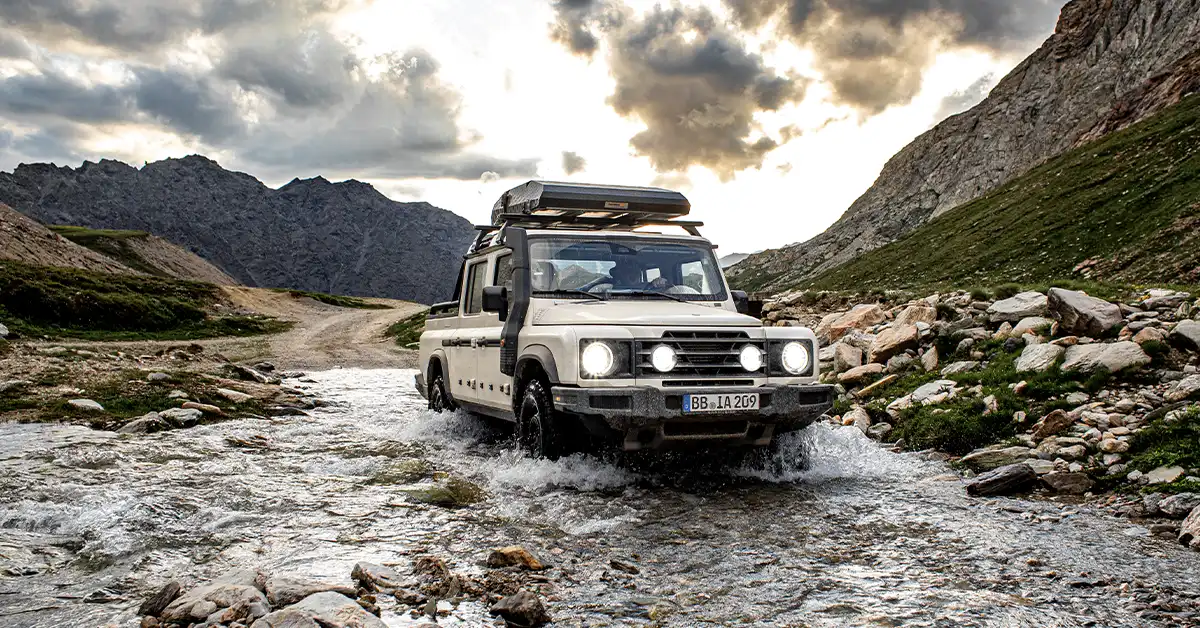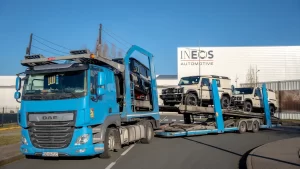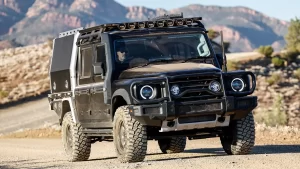The disbelief on a Defender driver’s face (and their quickly retracted hand) when he or she mistakenly does “the Land Rover salutation” upon seeing me approach in a Grenadier, never fails to amuse me. To add a pinch of salt to their wounded pride, I always make a point of returning their gesture with an enthusiastic wave.
When INEOS first announced their pickup, I was underwhelmed by its payload and overwhelmed by its price point…in comparison to other vehicles. Well, that was a somewhat superfluous piece of fact-finding on my part and the car came off pretty poorly. Don’t get me wrong, those are the facts and they may well apply in certain situations.
It’s easy to punch numbers into a spreadsheet and see which car is the heaviest, the most expensive, and has the lowest payload—or should that read which is the lightest, the cheapest, and capable of carrying the most without exceeding the maximum GVW. The internet and social media thrive on spectacular headlines: everything has to be either the biggest and best or the worst and most shocking. I don’t know about you, but I’m tired of hearing why something isn’t as good as something else…I’d rather know if something is up to the job for which it was intended, especially when the object of interest goes about things slightly differently.
Overlanding isn’t everyone’s cup of tea, but one thing must be said: our vehicle of choice (whether that be a bicycle, motorbike, car, van or truck) has to be good at coping with everything we and the planet can throw at it and cover long distances without faltering. So the question I really need to address is: is the INEOS Grenadier Quartermaster good at overlanding?
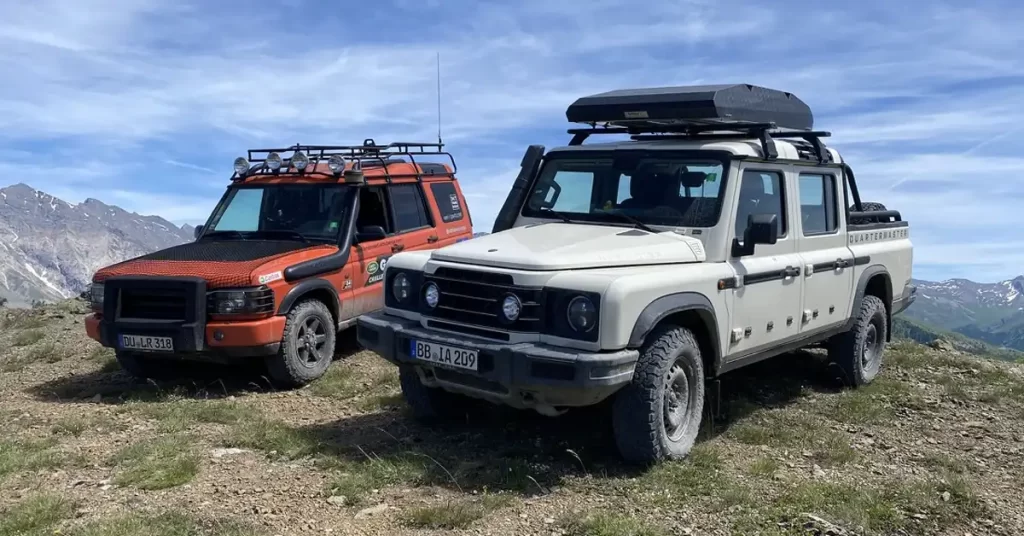
The only way to answer the question objectively is to live with the beast: go overlanding for several months and clock up thousands of kilometres. So that’s exactly what I did…and a lot was learned.
VEHICLE AS TESTED
INEOS was kind enough to loan me a left-hand-drive diesel-engined INEOS Grenadier Quartermaster Trialmaster. Yes, that’s quite a mouthful, but very much in keeping with the overall military flavour. If you are uncertain of the role of a Quartermaster, think Bond, think “Q.”
The suffix Trialmaster is drawn from Belstaff’s waxed cotton motorcycle jacket of the same name, which, incidentally, was the very first jacket (together with matching trousers) that I bought in 1977, when I started riding. The Trialmaster jacket, an icon of endurance in its own right, was originally developed to cope with the rough conditions riders faced when competing in the gruelling Six Days Trial motorcycle race. The lineup of celebrities that have worn the jacket is a tribute to its functionality and includes the likes of Sammy Miller, F1 driver Jackie Stewart, the King of Cool, Steve McQueen, and, more recently, Ewan McGregor of the Long Way Round, Up, Down franchise. But I digress…
True to its name, this particular Quartermaster Trialmaster (which from this point on shall be known as “Q”) was configured at the factory to cope with a harsh off-road environment and is equipped with BFGoodrich K02 tyres on 17” steel wheels, front and rear diff locks, snorkel, hard-wearing upholstery, hill descent control, auxiliary battery, and a 5.5-ton winch hidden in the front bumper. The car was further accessorised with the Saddle Leather Pack, a characteristic bovine hide covering for the steering wheel, handbrake and passenger grab handle.
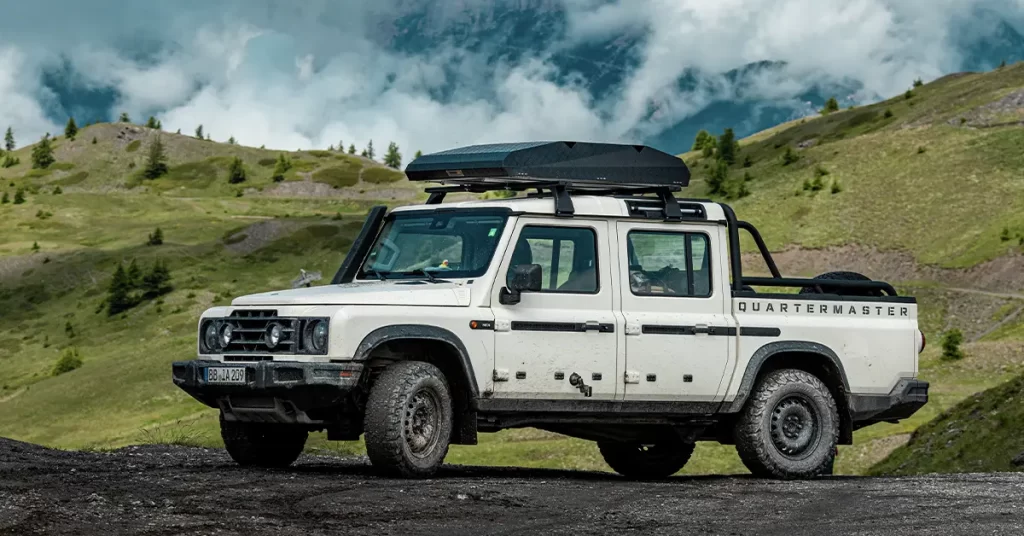
FIRST IMPRESSIONS
I’ve driven plenty of Grenadiers throughout its development and during the months following its launch, so I was already familiar with Q’s layout in the cockpit and how the car drives. Well, it’s a Grenadier isn’t it? Yes and no. It may well share its components and general characteristics, but Q isn’t just a Grenadier whose body has been chopped off aft of the second row seats and replaced by a pickup bed. The mighty box sectioned chassis has been stretched, the wheelbase has grown by a full 305 mm, and the overall length measures a stately 5.44 metres.
Driving through Cologne on the way home, I decided to take a detour in a bid to avoid the heavy traffic. This was indeed a spontaneous decision felled when I was a little further past the position in the road conducive to a favourable outcome…even for a normal car. As far as Q is concerned, I had unwittingly overshot big time. With the steering wheel on full lock, I grabbed an opportunity to insert myself between the two equally snail-like cars in the opposite lane. Good grief! An oil tanker has a tighter turning circle than the Quartermaster! With other cars so close on my tail I couldn’t reverse, I was left no choice other than to mount the pavement and smile apologetically at the pedestrians glaring at me across the bonnet. A lesson learned, just like when my driving instructor navigated me into a busy city centre strewn with road works and narrow lanes, in a full-size HGV and trailer.
Know thy vehicle and anticipate.
PACKING FOR A TRIP
Just to set the scene: I was travelling with my wife, Elisabeth, and our son, Tristan. So, three grown adults with cameras, drones, computers, and all the usual kit needed on a trip.
INEOS offers roof racks in different sizes along with a host of accessories to securely transport everything from a spare wheel to bicycles, sand planks, a hi-lift, tools, kayaks and much, much more. For me, I only had one thing in mind and, using a borrowed pair of Rhino Rack crossbars, I relocated the Alu Khosi rooftop tent from Larry (my 1963 Land Rover Series 2A) to Q.
Fact: the Quartermaster can carry a dynamic load of 125 kg with a roof rack. The static load is an impressive 420 kg.
With Elisabeth’s and my accommodation sorted (Tristan slept in a bivouac), I turned my attention to the pickup bed. Fitted with a resilient liner, the bed measures 1.564 mm long, 1.619 mm wide, and 485 mm high. Wise to the fact that we would most likely pick up things along the way, like logs for the campfire, I didn’t want to fully occupy the space with our kit. Our configuration included one Zarges (approx. 750 x 560 x 420 mm), a second Zarges (approx. 570 x 370 x 380 mm), a YETI Loadout GoBox (approx. 770 x 380 x 350 mm), a Lifesaver Jerrycan for safe drinking water (approx. 340 x 190 x 180 mm), a YETI Hopper Flip 18 Soft Cooler (approx. 450 x 290 x 320 mm) and a YETI Duffle (approx. 710 x 400 x 28 mm). Plenty of dust/watertight space to stow our gear and ample room remaining for logs and more. There are four lashing points in the bed and this worked well, but airline rails would be an improvement offering more flexibility.

I took along the YETI Cooler because Q has a roll bar and not the canvas tilt and frame or the Roller Tonneau. I didn’t think that leaving a fridge on the back where it would be subjected to the elements (and prying eyes) was a good idea. Mind you, if you do have a cover, it is worth noting that the bed is fitted with a 230V, 400W socket, a 12V socket, and an LED lamp.
Fact: there are two 230V sockets, one in the bed and one inside the cabin. These only work when the engine is running. Even with the auxilliary power switch on, they remain dormant. A bit puzzling when you consider Q has a second battery inedpendent of the starter battery.
As far as payload is concerned, the diesel will carry 760 kg and the petrol up to 835 kg. I think that for most overlanders the payload is adequate, and we certainly didn’t need more during the test period. Depending where a future journey might take us, I could still add an extra tyre and some parts.
The tailgate can support a whopping 225 kg when opened and is just the right height to stand/sit on, to use as a bar, or to support the kitchen.
On the subject of the kitchen, we took the MOKUBO along for practicality because you can cook and serve up to four people with its contents. Again, this is something we didn’t want to leave out in the elements, so it wandered into the cabin and sat on the folded down seats behind the driver. But more on the passenger compartment later.

ON-ROAD DRIVING
In advance of our first tour, I had to run around town collecting provisions, and even visit a client several hundred kilometres away. So this gave me an excellent opportunity to see how Q handled and behaved unladen in an urban environment. Progressive coil springs on both of the solid axles are a great recipe for comfort. Sure, when there is no load on the back axle, the ride is firm, but even so, firm does not imply uncomfortable or skittish. Far from it.
If you own a Quartermaster, you probably don’t want to have to go into town too often and, if you do, you will be avoiding the multi-storey car parks. The 14.5-metre turning circle was a hindrance in some of the small historic villages we visited—not so much for me, because I knew how much space I needed, but for those behind me who had to back up and give me space to manoeuvre.
Realistically, Q isn’t ideal for finding a parking space or navigating a modern city, but which overland vehicles are? It’s a small, but acceptable, compromise. Having said that, other road users in city-biased cars do tend to give a wide berth when they are at eye level with the imposing couch-like front bumper.
A car of this size, with its curb weight of 2.7 tons, needs to be able to swim with the town traffic. A task the 3-litre straight-six diesel mastered nonchalantly with little more than a friendly growl from its exhaust. So how about the highway?
Fact: BMW supply both the diesel and petrol engines which produce 249 BHP / 550 Nm and 286 BHP / 450 Nm respectively. The engine has been mapped specifically for INOES’ combined on- and off-road use.
The gearabox is an 8-speed ZF automatic hooked up to a Tremec transfer case with low range and a central diff lock.
Beginning in central Europe, we had to cover 946 km on asphalt highways before we reached the starting point of our off-road tour across the Western Alps. The plan was to catch up with Stefan, who was in his Land Rover Discovery 2, and drive down together. But he had a good head start.
With a top speed of 160 kmh and completing the dash from 0-100 kmh in around nine seconds, the Grenadier isn’t going to win any drag races. Even so, steer it onto a German autobahn, dial in the cruise control at 120, and enjoy a relaxing drive as the suspension swallows up surface irregularities and the long wheel base assists at keeping the ship straight.
Nothing rattles on or in this car. Everything is solidly mounted, and the doors close with a reassuring dense clunk…even if they do need a firm pull to overcome the rubber seals.
All 2024 Grenadiers have a compulsory speed warning built in that starts clicking as soon as you exceed the speed restriction sign the camera (thought) it last read. I don’t know what it was looking at, but the display would show a speed limit and the clicking would begin even if there weren’t any restrictions. Yes, you can programme this feature out, but it returns every time you switch on the ignition. I found that if you ignore it long enough, it fades into the subconscious. The same as the lane control which (mostly) chimes in when you cross a line without indicating, but doesn’t pull at the steering wheel.
The power-assisted recirculating ball steering is typically long-winded insofar as you need to turn the steering wheel a bit more than with rack and pinion and it doesn’t self-centre when pulling away from a bend. As you will see later when I talk about off-road driving, there are significant advantages to this system which outweigh the on-road characteristics by far. To be honest, once you’re on the road, it only takes a short while before you’re used to how it works.
PASSENGER CELL
Fact: The Grenadier’s body is mostly made of steel with alumium bolt-on panels. Characterised by its boxy silhouette, it has a friendly familiarity about it.
The Grenadier Quartermaster is comfortable on short and long distances for most adults, in the front seats that is. Adults in the second row do not have the luxury of adjustable seats or an abundance of leg room like those up front, but headroom is good for everyone even if taller companions in the back will struggle to look out of any windows—the seat cushion is quite high and the roof is pulled down at the sides. There are plenty of charging points though, including a 230V socket.
FRONT SEATS
The driver’s and front passenger’s seats are spacious. I am nearly two metres tall and have plenty of space to get comfortable in. The driver’s seat slides back further than I need, my shoulder isn’t butted up against the B-pillar, and there is bags of headroom. Something I really appreciate is the wide and horizontal armrest at the base of the door window. It begs for you to rest your arm there on long stints at the wheel.
But not everything is rosy. Firstly, the B-pillars are massive, and with the seat pushed back into a comfortable position, over-the-shoulder glances are hampered. Secondly, I find the Recaro seats aren’t as good as they could be. They would benefit from lumbar support in the backrest and an extendible seat cushion. Maybe someone at INEOS Automotive will consider these revisions now that a new supplier needs to be found to replace Recaro.
REAR SEATS
The rear seats are also out of the Recaro factory and pretty much as good as you can expect in a double-cab pickup. The backrest is fairly upright, but that’s not necessarily a bad thing. However, second row adult passengers do have some other issues to cope with. The rear seat footwell is not generous by any stretch of the imagination, meaning feet are cramped and long journeys are uncomfortable.
A couple of other points rear passengers need to contend with: the bottle holder in the rear door takes a decent sized bottle, but you can’t actually retrieve it when you’re seated with the door closed. The grab handle in the roof is positioned too far back to be useful, and when you want to exit the rear seat, you need to turn yourself 90° because otherwise the door is in your way.
Now, because we only needed one rear seat on our journeys, we folded the twin seat flat to gain more space to keep some things like jackets and other items easily accessible, including the MOKUBO kitchen which has the same rectangular footprint (60 x 40 cm) as a Eurobox. If the rear doors would open to a full 90°, you could do so much more with the space inside because it would be more accessible. If I were to use Q on a long distance trip with only two people, I would remove the rear seats completely and install slide-outs to maximise the available space.
AIR CONDITIONING
Maybe this is just a singular occurrence peculiar to this particular car, but the aircon is, well, less than effective. With the sun burning against the windows and bodywork from the outside, turning the temperature control knob doesn’t actually have a huge effect on the indoor climate. Dialling up the fan is akin to turning up the volume…you can hear the fan blades whizzing around faster, but the volume of air passing through the outlets is less than impressive. This is the hottest time during a European summer, I wonder how the system will fair in the depths of winter.
BUTTONS AND SWITCHES
Call me old school, but I sympathise with the designers because I, too, prefer real buttons and switches to touchscreen alternatives. When it comes to the Grenadier, however, it means there are a lot of them. So, like it or not, the roof panel is about as good as it gets (even if it does speak to the squadron leader in some of us). Imagine trying to squeeze all those controls into the dashboard—the split between everyday controls in the dash and work/off-road in the roof is about as practical as it comes, and you soon get used to where everything is.
In addition to the factory-installed equipment, the roof panel has several pre-wired switches for goodies such as auxiliary lighting on a roof rack which can draw its electricity from power sockets adjacent to the lashing rails on each side of the roof. Now, that is just plain practical and saves drilling holes and dismantling the interior so that you can thread cables.
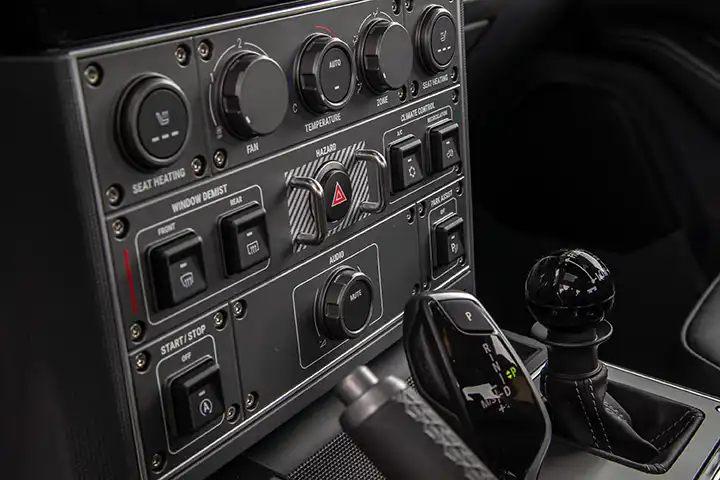
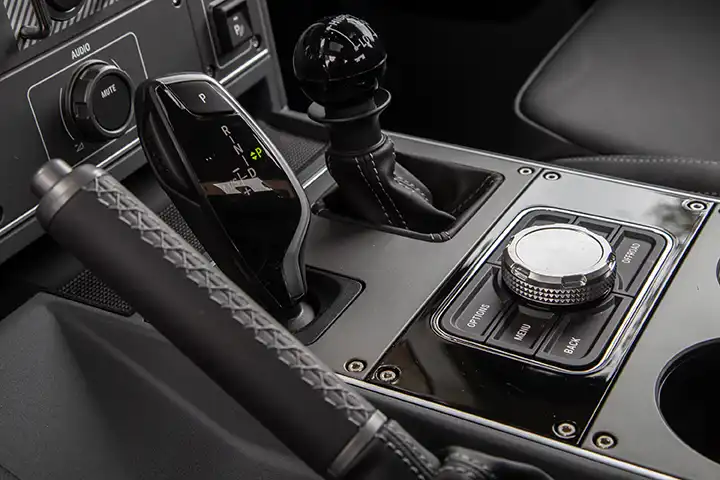
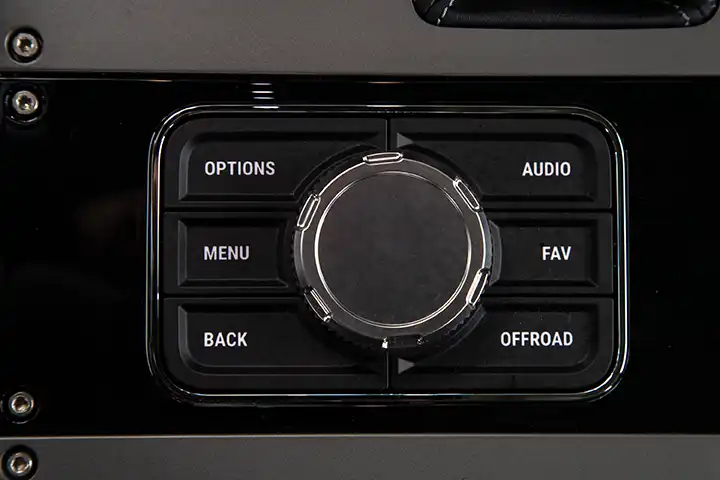
Between the front seats is a large control dial and some push buttons which add an extra layer of practicality (even with gloves on) when navigating functions on the centrally positioned infotainment screen.
All switches and controls are protected against the ingress of dust and water spray—a logical detail when you consider you can rinse out the footwells with a hose and splashes are almost certainly unavoidable.
INFOTAINMENT
There are two screens. One directly in front of the driver, which, unless you are using some of the off-road functions, you hope will remain dark. The only reason a light would go on when driving through the urban jungle is when there is something untoward such as low tyre pressure, oil levels, AdBlue tank, or other perils. In off-road mode, the screen provides confirmation, for example, when in low range and the diff locks are engaged.
The centre of the dashboard is occupied by a 12.3” touchscreen. One third is dedicated to typical driving info such as road speed, engine revs, what gear you are in, and how much is left in the fuel tank. The other two thirds control/display audio, Apple CarPlay (via wired or Bluetooth connection), Android Auto (via a wired connection). With everyone able to seamlessly integrate their phones into the system, it’s not surprising that INEOS didn’t bother developing their own street navigation.
The display content changes when your are in off-road mode, providing more relevant information such as how much torque is provided to each wheel, angle and pitch of the vehicle, and more. You can even access INEOS’ own Pathfinder waypoint navigation system.
Is it disadvantageous having the information in the centre of the dashboard? Basically, no. This isn’t an INEOS invention. My Series 2A Land Rover has the dials in the centre, even the latest Mini, along with many other makes and models, have screens in the middle. It’s one of those features you quickly get used to.
OFF-ROAD
There is a lot to like about the Grenadier Quartermaster once you leave the pavement, and I had a good chance to get to know it better in the Western Alps. The brand’s slogans “Built on Purpose” and “Built for More” are an unsubtle hint that this is where the car feels most at home.

STEERING
The recirculating ball steering, which some road-goers seem to struggle with, is destined to be navigating through thick scrub and rough terrain. If you hit a rut or a rock which may well be hidden from view, then you won’t suffer from the steering wheel suddenly snatching with wrist-breaking brutality. Off-road situations demand that the driver has control and makes deliberate decisions. The steering setup makes you feel you are in full control at all times and works in your favour.
The 14.5 m turning circle became quite apparent when I was following Stefan’s Land Rover Discovery up the mountain tracks. He would simply drive around a tight hairpin and power into the distance while I did some 3- or 4-point turns. Having said that, and just to prove that every car has its limits, he too had to manoeuvre on several occasions.
AXLES
When the INEOS engineers were looking for tough axles, they tried and tested all the usual sources only to determine nothing met their expectation. So, they decided to spec their own and have them built by Carraro, a company specialising in drive-train solutions for off-highway vehicles. Solid axles are ideal for driving off-road and these will be difficult to break.
SUSPENSION
Progressive coils springs on all four corners ensure a comfortable ride and plenty of axle articulation. Pickups often have leaf springs on the rear axle which are specced to cope with heavy loads. This can make them reasonably hard when not laden, which in turn makes the rear axle less responsive to the terrain and transmits lumps and bumps to passengers.
TORQUE
The BMW 3.0-litre diesel has plenty of grunt. 550 Nm fully available well down the rev range. This equates to relaxed and confident driving in almost any scenario, with or without a full load.
LOW RANGE
Changing in and out of low range is a manual affair. Grab the lever, lift the collar, and pull back firmly to engage the low ratios. Lift the collar and push the lever to one side to engage the centre diff lock.
Engaging low range and the central diff lock are mechanical/physical operations (as opposed to electronically assisted) and can require a little patience and rocking to switch back into high range.
The low range ration is 2.5:1 and, under normal conditions, the car will set off in second gear and automatically change up. Changing up manually adds more control and prevents any unwanted gear changes. Selecting first gear gives you a very slow crawling speed.
REAR AND FRONT DIFF LOCKS
Once you have the centre diff lock engaged, you can control the rear and front diff locks via the roof panel. Rear and front diff locks can be engaged while stationary or on-the-fly up to a maximum speed of 15 km/h.
HILL DESCENT CONTROL
Descending a long, steep and loose-surfaced black ski slope (albeit without any snow) provided an excellent opportunity to test the Hill Descent Control. Engaged via a button in the roof panel, you set the desired speed using the cruise control buttons on the steering wheel and keep your feet away from the pedals. With the car moving slowly on a very steep and rocky section of the piste, the conversation between the wheels, drive train and the terrain was clearly audible and very controlled.
OFF-ROAD SWITCH
There is a button in the roof panel for off-roading which switches off the park distance control sensors to prevent them beeping furiously at high grass and other objects. It also turns off the audible seat belt warning even if the warning light still ignites.
WADING MODE
I didn’t need this on the tour through the Western Alps, but if you are entering deep water, then this will turn off the electric fan at the radiator to prevent damage—a bit more luxurious and user-friendly than loosening the fan belt on my 1963 Land Rover. Wading mode does require for the vehicle to be in low range with the centre diff lock engaged. If the engine is hot, then wading mode won’t engage until it has cooled down to a temperature the computer thinks is suitable.
The wading depth is 800 mm even with the factory snorkel installed. The factory snorkel is designed to gulp down air from a high level in dusty environments and not to increase wading depth.
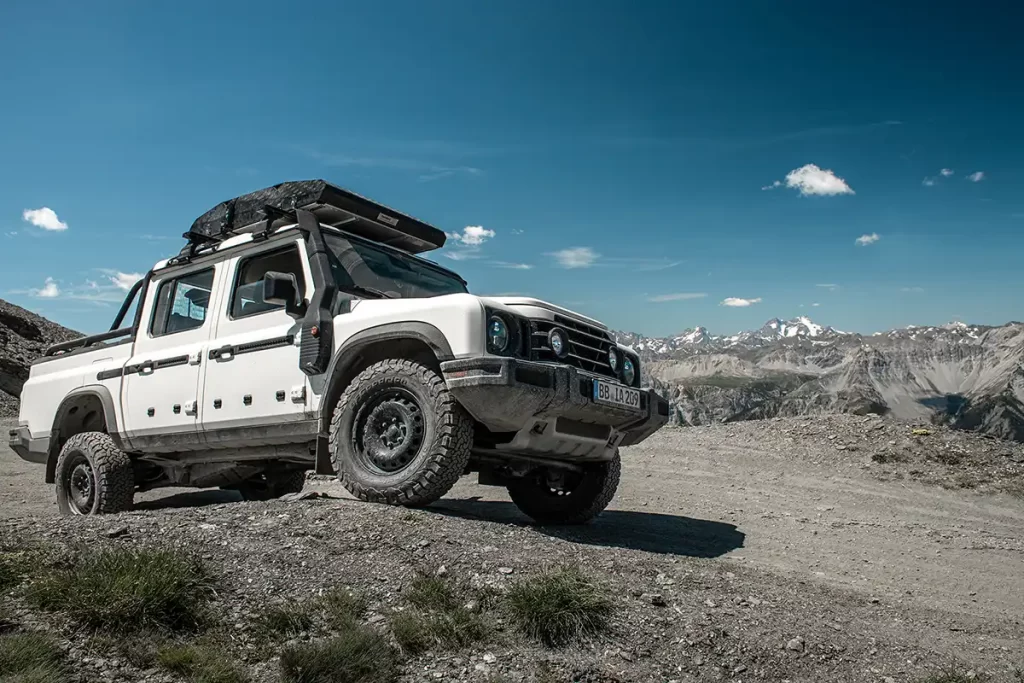
CONCLUSION
The INEOS Grenadier Quartermaster is a double-cab pickup with a payload of between 760 and 835 kg and a lofty price tag. As far as overlanding is concerned, the payload works in most cases and the price tag (if you look at the fetching price of a suitably equipped Classic Defender) isn’t so far off the mark. Yes, there are cheaper pickups available, but do they offer the occupants the same level of comfort, bulletproof mechanical components, an engine with as much grunt as an angry hippo, and an overall solidity that you can expect from even more expensive saloons? Probably not.
I’ve driven long stretches on boring autobahns, I’ve meandered up and down scenic mountain roads, and I’ve spent days crawling unpaved and loose Alpine tracks well beyond any urban infrastructure. Did the Quartermaster perform? Damn right it did. Was it faultless? No. It’s big, heavy, needs a lot space for u-turns, and the double-cab’s rear seats are cramped for adults less vertically challenged (footwell). But these aren’t setbacks as such. They lie typically in the nature of the type of vehicle the Grenadier Quartermaster represents in every sense.
I appreciate details like pre-wired switches and power sockets in the roof. I like the practicality of the interior layout and how the vehicle drives and feels. Yes, the car is responsive and the driver is still very much part of the driving experience and aware of the terrain beneath the wheels.
What I don’t like are the missing adjustable lumbar support in the front seats, the cramped footwells in the second row, the fact that the 230V power sockets do not work when the car is stationary with the engine turned off, and that the rear passenger doors don’t open to a full 90°.
In a nutshell, the Quartermaster really is Built for More. It’s got solid components, a powerful drive train and more offroad capability than most people will need. This pickup is easily customisable and will take you everywhere.
Is the Quartermaster good at overlanding? Simply, yes.
I have now driven the Quartermaster extensively during the warmer months and look forward to extreme winter testing early in 2025.
